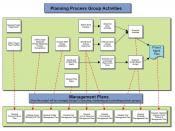The functions of management planning can range from highly complex to just simple and basic. Nonetheless, the significance of planning continues to be the most valuable tool to an organization's success. The purpose of this paper will summarize an article about basic guidelines and typical phases in management planning. The types of managerial plans and their differences and similarities will be discussed. Concepts of this article will be related to my own organization. The relationship among environmental and social considerations of management plannng will be explained.
Summary of Article
The article refers to planning as setting the direction for something--some system--and then working to ensure the system follows that direction. The scope of the following planning information is to the "system", which can be the entire organization, or its departments, and/or group processes. It explains that systems consist of inputs, processes, outputs, and outcomes. Inputs go through a process where they are aligned, moved along and carefully coordinated, ultimately to achieve the goals set for the system.
Outputs are tangible results produced by processes in the system (McNamara, 1999).
The "system" accepts inputs (resources such as raw materials, money, technologies, and people) and produces outputs (products or services for consumers). Outcomes are said to be known as benefits for the consumers, such as jobs for workers and enhanced quality of life for customers. The process of planning in its larger context includes planners working backwards through the system. They start from the results (outcomes and outputs) they prefer and work backwards through the system to identify the processes needed to produce the results. Then they identify what inputs (or resources) are needed to carry out the processes (McNamara, 1999).
Various phases of planning are outlined that should be carried out carefully to ensure successful planning and...



Good
Descriptive
2 out of 2 people found this comment useful.